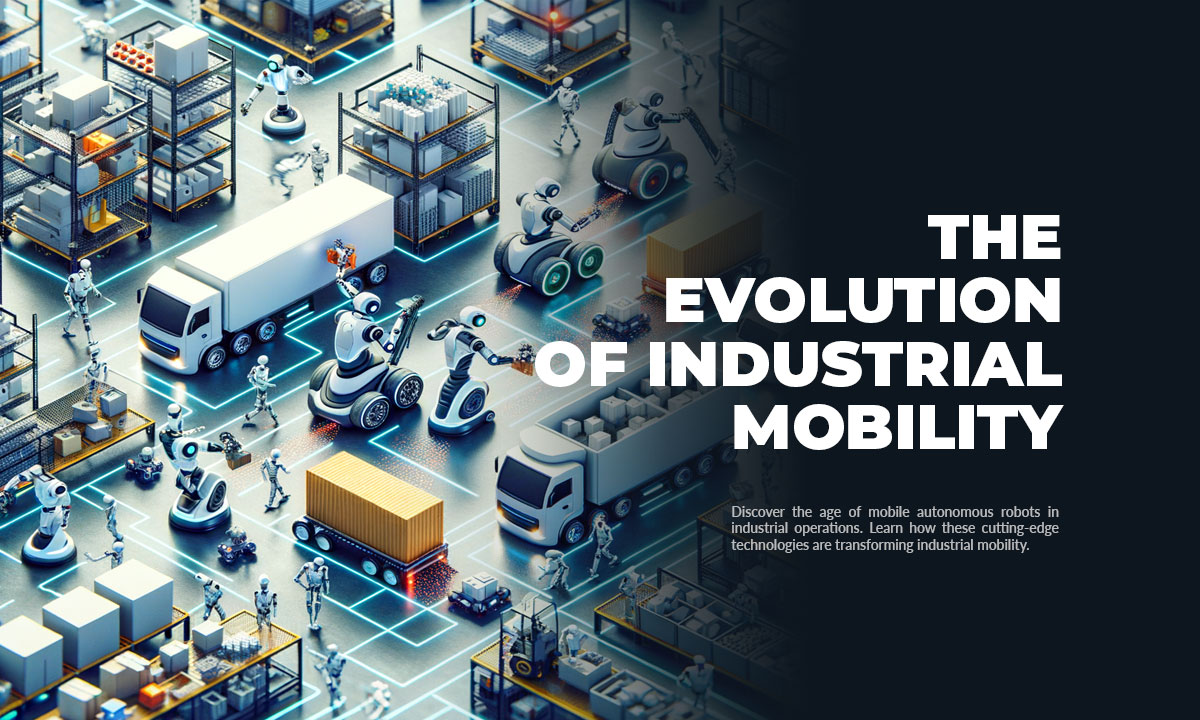Industrial mobility has come a long way since the early days of manual labor and fixed machinery. Over the years, technological advancements have revolutionized the way industrial operations are carried out, leading to increased efficiency, productivity, and safety.
Introduction: The Evolution of Industrial Mobility
One of the most groundbreaking developments in this evolution is the introduction of mobile autonomous robots.
These robots have redefined the concept of mobility in industrial settings by offering a new level of flexibility, autonomy, and intelligence. They have the potential to transform the landscape of industrial operations, offering a wide range of benefits such as streamlined workflows, enhanced safety, and cost savings.
Understanding Mobile Autonomous Robots
Mobile autonomous robots are self-guided machines equipped with sensors, navigation technology, and advanced software algorithms that enable them to operate independently in dynamic environments. Unlike traditional industrial robots that are often fixed or operate within predefined boundaries, mobile autonomous robots have the ability to navigate and perform tasks in unstructured and changing surroundings.
These robots can autonomously adapt to their environment, avoid obstacles, and make decisions based on real-time data, making them highly versatile and efficient. They are designed to perform a variety of tasks such as material handling, inspection, surveillance, and logistics, offering a wide range of applications across different industries.
Furthermore, mobile autonomous robots are designed to collaborate with human workers, augmenting their capabilities and improving overall operational performance. Their advanced mobility and autonomy capabilities make them invaluable assets in today's rapidly evolving industrial landscape, where agility, efficiency, and safety are of utmost importance.
Advantages of Mobile Autonomous Robots in Industrial Settings
Industrial landscapes are constantly evolving, and mobile autonomous robots stand at the forefront of this transformation. These mobile automatons offer a myriad of advantages, fundamentally altering the dynamics of traditional workflows. Their integration within industrial settings significantly boosts efficiency. Autonomous robots excel in repetitive and labor-intensive tasks, allowing human workers to focus on more complex responsibilities that require creative thinking and problem-solving skills.
Another remarkable advantage of mobile autonomous robots is their remarkable precision. Equipped with sensors and guided by advanced algorithms, they execute tasks with a level of accuracy that minimizes the wastage of materials and ensures consistent product quality. Safety is yet another crucial benefit. Robots tirelessly perform hazardous duties in unsafe environments, thereby reducing workplace accidents and ensuring employee well-being. Moreover, these robots are imbued with adaptability, capable of operating 24/7, eliminating downtime, and providing a substantial uplift in productivity.
Cost reductions are also inherent when employing mobile autonomous robots. While the initial investment may be significant, over time these robots lead to savings on labor costs and minimize errors related to human fatigue, thus creating a more streamlined and cost-effective operation. Additionally, data analytics and machine learning enable these autonomous units to continuously improve workflows and adapt to changing conditions within industrial premises. This factor alone positions them as a quintessential element in the pursuit of industry 4.0.
Applications of Mobile Autonomous Robots in Various Industries
The versatile nature of mobile autonomous robots means their applications are diverse across multiple sectors. In the manufacturing industry, these robots undertake tasks such as material handling, assembly, packaging, and inspection. They seamlessly integrate into production lines, communicating with other machines to optimize the manufacturing process.
In warehousing and logistics, mobile autonomous robots revolutionize inventory management and order fulfillment. They navigate vast storage facilities with ease, picking and transporting products, and significantly reducing the time from order to delivery. In the agricultural sector, these robots perform a range of jobs from planting and weeding to harvesting and monitoring crop health, thus optimizing yield and resource usage.
Furthermore, healthcare institutions are beginning to harness the power of mobile autonomous robots for transporting medical supplies, sanitizing facilities, and even assisting in complex surgical procedures. The pharmaceutical industry employs them for tasks that require high precision and cleanliness, such as drug formulation and testing.
These are just a few instances of the wide-ranging applications of mobile autonomous robots. As technology advances, more industries are poised to adopt these innovative systems, uncovering new efficiencies and opportunities for growth and improvement in their operations. As a vessel of modern industry, mobile autonomous robots represent not just a tool, but a pivotal force driving the march towards an automated, intelligent future in industrial settings.
Key Technologies Driving Mobile Autonomous Robots
Mobile autonomous robots are revolutionizing industrial mobility by leveraging cutting-edge technologies to enhance efficiency and productivity. These robots are powered by a combination of advanced technologies that enable them to navigate, perform tasks, and communicate seamlessly.
1. Sensing and Perception Technology: Mobile autonomous robots rely on sensors such as LiDAR, cameras, and ultrasonic sensors to perceive their environment and make real-time decisions. These sensors provide crucial data for navigation, obstacle avoidance, and object manipulation.
2. Localization and Mapping: Using simultaneous localization and mapping (SLAM) algorithms, autonomous robots can create maps of their surroundings and determine their precise location within the environment. This technology is fundamental for accurate navigation and efficient path planning.
3. AI and Machine Learning: Mobile autonomous robots integrate AI and machine learning algorithms to analyze data, learn from their experiences, and adapt to dynamic environments. These capabilities enable robots to optimize their performance, make predictive maintenance decisions, and enhance their overall autonomy.
4. Communication and Connectivity: Seamless communication is critical for coordinating multiple robots and integrating them into existing industrial systems. Technologies such as 5G, Wi-Fi, and industrial IoT protocols facilitate reliable connectivity and enable robots to share data and coordinate tasks in real time.
These key technologies collectively empower mobile autonomous robots to navigate complex environments, collaborate with human workers, and execute tasks with unprecedented precision and efficiency.
Challenges and Concerns in Implementing Mobile Autonomous Robots
While the potential benefits of mobile autonomous robots are substantial, their implementation is not without challenges and concerns that need to be addressed for successful integration into industrial operations.
1. Safety and Reliability: Ensuring the safety of human workers and the reliability of autonomous robots is paramount. Robust safety measures, fail-safe mechanisms, and thorough risk assessments are essential to mitigate potential hazards and instill confidence in the technology.
2. Regulatory Compliance: Navigating the complex landscape of regulations and standards governing industrial robotics requires meticulous adherence to compliance requirements. Ensuring that autonomous robots meet industry-specific regulations and safety standards is crucial.
3. Integration with Existing Infrastructure: Seamless integration of autonomous robots with existing industrial infrastructure, machinery, and processes poses a significant challenge. Compatibility, interoperability, and minimal disruption to ongoing operations must be carefully addressed.
4. Skills and Training: The deployment of autonomous robots necessitates training personnel to operate, maintain, and interact with these advanced systems. Building the necessary skill sets and providing comprehensive training programs are vital for successful adoption.
Addressing these challenges and concerns is pivotal to unlocking the full potential of mobile autonomous robots in industrial settings, paving the way for enhanced productivity, efficiency, and operational excellence.
Conclusion: The Impact of Mobile Autonomous Robots on Industrial Mobility
Mobile autonomous robots have ushered in a revolutionary era in industrial mobility, offering unprecedented flexibility, efficiency, and safety for various operations. As industries continue to evolve and adopt advanced technology, the integration of mobile autonomous robots has become a game-changer in optimizing processes and enhancing productivity. The deployment of mobile autonomous robots in industrial settings has redefined the traditional approach to material handling and logistics. These robots can autonomously navigate through complex environments, transport goods, and execute tasks with precision, thereby streamlining operations and reducing manual labor requirements. This not only accelerates the pace of work but also minimizes the risk of workplace accidents, contributing to a safer working environment. Moreover, the introduction of mobile autonomous robots has significantly transformed the concept of maintenance in industrial facilities. These robots can be programmed to conduct routine inspections, identify anomalies, and even perform minor repairs, presenting a proactive approach to facility upkeep. By leveraging sensors and data-driven insights, these robots enable predictive maintenance, thus preventing unexpected breakdowns and optimizing the lifespan of equipment. In the realm of inventory management, mobile autonomous robots have proven to be indispensable assets, capable of efficiently organizing inventory, conducting inventory counts, and swiftly retrieving items when needed. This precision and agility in managing inventory not only enhance operational efficiency but also facilitate accurate order fulfillment and inventory accuracy. In essence, the incorporation of mobile autonomous robots into industrial mobility has not only elevated operational efficiency but also nurtured a more agile, responsive, and safer industrial landscape.

























